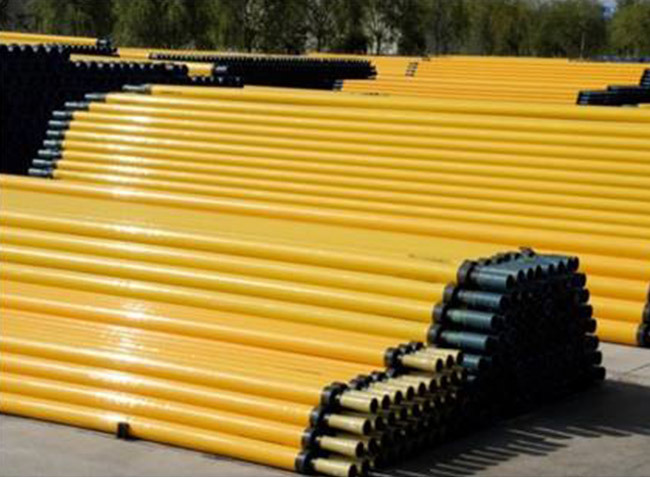







Fiber wound fiberglass pipe
Classification: Products
Keywords: polyester glass steel pipe, polyester glass steel pipe
The main products are: polyester glass fiber reinforced plastic pipe, epoxy glass fiber reinforced plastic pipe, glass fiber reinforced plastic equipment container, tower, flue, glass fiber reinforced plastic pultrusion molding profile and carbon fiber series and other high-performance fiber composite materials.
Fiber wound fiberglass pipe
Fiber-wound glass steel pipe is based on thermosetting polyester resin as the matrix, glass fiber and its products as reinforcing materials, using reciprocating winding microcomputer control production technology.
1. product performance characteristics
1, corrosion resistance: the atmosphere, water and the general concentration of acid, alkali, salt and a variety of oils and solvents have good resistance.
Light weight: excellent physical properties, light weight and high strength: density 1.5~2.0g/cm3, 1/4~1/5 of steel. But the tensile strength is close to steel, up to 400MPa.
Long service life: up to 50 years.
4. The inner wall is smooth, the absolute roughness is 0.0084, and the flow rate of the same pipe diameter is 15% ~ 20% larger than that of other pipes.
The construction is simple, the construction efficiency is high, and the installation speed is 5 to 10 times that of other pipes.
6, the design is strong, the pipe wall does not scale, the water quality will not produce secondary pollution. Through the selection of food grade lining resin, it can meet the requirements of GB 5749 "drinking water health standards" and the UK WRAS drinking water safety certification.
Wide range of 2. applications
Due to the extremely excellent performance-to-price ratio of glass steel pipes and a wide range of applications, they have been widely used in various fields such as electric power environmental protection, municipal construction, petrochemical, and marine ships.
3. product specifications
◆ Diameter (mm):DN15 ~ DN5000;
◆ Pressure rating (MPa):0.1, 0.25, 0.4, 0.6, 0.8, 1.0, 1.2, 1.4, 1.6, 2.0, 2.5;
◆ Stiffness grade (N/m²):SN1250, SN2500, SN5000, SN10000;
◆ Standard effective length: 6m, 12m;
Other pressure grade, stiffness grade, non-standard length of the tube can be customized processing.
4. connection mode:Sub-flexible (socket) and rigid (cementing) two major types of joints.
5. execution standard
JC/T552-2011 Filament Wound Reinforced Thermosetting Resin Pressure Pipe
GB/T21238-2007 "glass fiber reinforced plastic sand pipe"
DL/T802-2007 Glass Fiber Reinforced Plastic Cable Conduit
ANSI/AWWA C950 "Glass Fiber Reinforced Plastic Pressure Pipe Fiberglass pressure Pipe"
AWWA M45-2005 《Fiberglass pipe design manual》
GB50332-2002 Code for Design of Pipeline Structure of Water Supply and Drainage Engineering
ASTM D2996 《Specification for Filament-Wound "Fiberglass" (Glass-Fiber-Reinforced Thermosetting Resin) Pipe》
ASTM D3262 《Specification for Fiberglass (Glass-Fiber-Reinforced Thermosetting-Resin) Sewer Pipe》
ASTM D3517 《Specification for Fiberglass (Glass-Fiber-Reinforced Thermosetting-Resin) Pressure Pipe》
ASTM D3754 《Specification for Fiberglass (Glass-Fiber-Reinforced Thermosetting-Resin) Sewer and Industrial Pressure Pipe》
DIN 16868 《Glass fiber reinforced unsaturated polyester resin (UP-GF) pipes》
BS 5480 《Specification for Fiberglass (GRP) pipes, joints and fittings for use water supply or sewerage》
BS 7159 Code of practice for design and construction of glass-reinforced plastics (GRP) piping systems for individual plants or sites
ISO 10639 《Plastics piping systems for pressure and non-pressure water supply - Glass-reinforced thermosetting plastics (GRP) systems based on unsaturated polyester (UP) resin》
ISO 14692 Petroleum and natural gas industries-Petroleum and natural gas industries - Glass-reinforced plastics (GRP) piping
Forging is a processing method that uses forging machinery to apply pressure to metal blanks to produce plastic deformation to obtain forgings with certain mechanical properties, certain shapes and sizes. Forging (forging and stamping) is one of the two major components. Forging can eliminate the defects such as loose casting in the smelting process and optimize the microstructure. At the same time, due to the preservation of the complete metal flow line, the mechanical properties of forgings are generally better than castings of the same material. Related machinery in high load, severe working conditions of important parts, in addition to the shape of a relatively simple available rolling plate, profile or welding parts, the use of forgings.
Previous Page
Next Page
Previous Page
Next Page
Related Downloads
Related Products
Online consultation

Pay attention to WeChat public number
Copyright©2023 Anhui xinhe new material co.,ltd | Business License | Powered By:300.cn | SEO









 025-57492608
025-57492608




